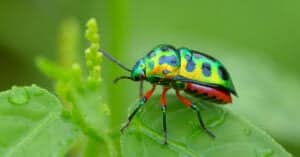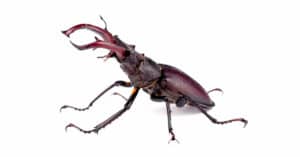There are tons of different black and yellow beetles out there. If you see one, what you’re looking at depends greatly on where you are.
Here’s a list of black and yellow beetles. It isn’t comprehensive by any means, as there are dozens and dozens of different species (and some may yet be discovered). However, here is a list of the most common black and yellow beetles.
1. Colorado Potato Beetle
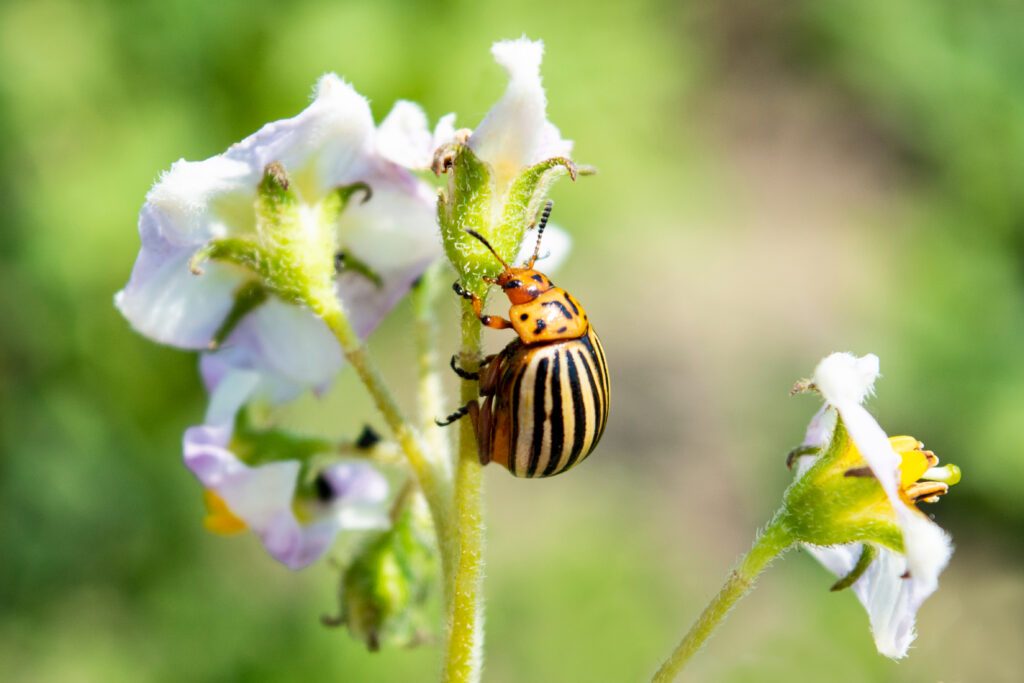
Potato beetles are a yellowish-orange color with black stripes.
©Mr. Background/Shutterstock.com
This species of beetle is native to North America. However, it has spread throughout the world, including Europe and Asia. They are very common pests on potatoes and other nightshades, like tomatoes.
Adults measure around 10 mm long. They’re often bright yellow with an orange head. Their body has black stripes that run lengthwise. They usually have ten stripes on each wing.
The larvae of this beetle are also striped and range in color from reddish-brown to yellow. They’re often found on the undersides of potato leaves, where they feed and cause significant damage to the plants.
These beetles often need to be controlled and managed by farmers. Crop rotations, natural predators, and insecticides all help control the population. However, these beetles can develop a resistance to insecticides, so other management options are preferred.
Despite its reputation as a pest, the Colorado potato beetle is also an interesting and important species from an ecological perspective. It plays a role in local food webs as a food source for birds and other predators. It may also have other, as-yet-undiscovered ecological interactions with other plants and animals.
2. Spotted Cucumber Beetle

Spotted cucumber beetles rarely grow larger than 0.2 inches.
©iStock.com/Brett_Hondow
The Spotted Cucumber Beetle can be found throughout North America. They’re a type of leaf beetle easily distinguished by their black spots. They measure around 6 to 8 mm and have an oval-shaped body.
They’re often very bright green or yellow, with about 11 black spots. The legs and antennae are also bright yellow.
These bugs feed on foliage and fruits. While they often feed on cucumbers, they may also consume melons, beans, corn, and melons. They can cause serious damage to crops, especially in large numbers. Spotted cucumber beetles may also spread common plant diseases, such as bacterial wilt and mosaic virus.
Their grubs are small and white. They live in the soil and feed on the root of plants. Therefore, they can also seriously damage plants, especially potatoes, and carrots.
Farmers control these beetles using various methods, such as insecticides and crop rotation. Many farmers also utilize physical barriers to protect their crops from damage.
3. Golden Tortoise Beetle
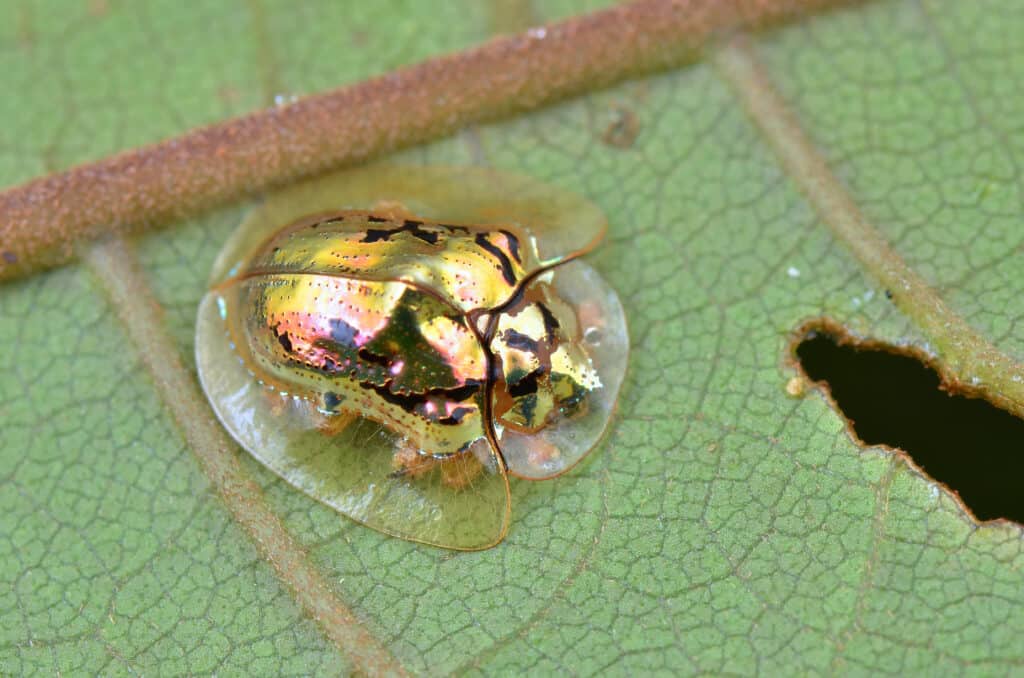
A golden
tortoise
beetle sits upon a leaf.
©SIMON SHIM/Shutterstock.com
The Golden tortoise beetle is native to the Americas. It’s known for its vibrant golden color, hence its name. Furthermore, this beetle can change colors, so it sometimes appears reddish-brown or copper. They can also develop stripes of various colors, including red and black. This behavior helps them stay out of site.
These small beetles measure between 6 to 8 mm long. They have a shield-like body that’s flattened. When not colored, they can look see-through.
Golden tortoise beetles feed on many different plants. They hang onto the undersides of leaves and feed on the soft parts. They can damage crops but aren’t often considered serious agricultural pests.
When threatened, these beetles will change colors and release a sticky substance. This substance contains chemicals that may repeal predators.
These beetles can be a key part of many ecosystems. They can help pollinate plants and provide food for other animals.
4. Black and Yellow Longhorn Beetle
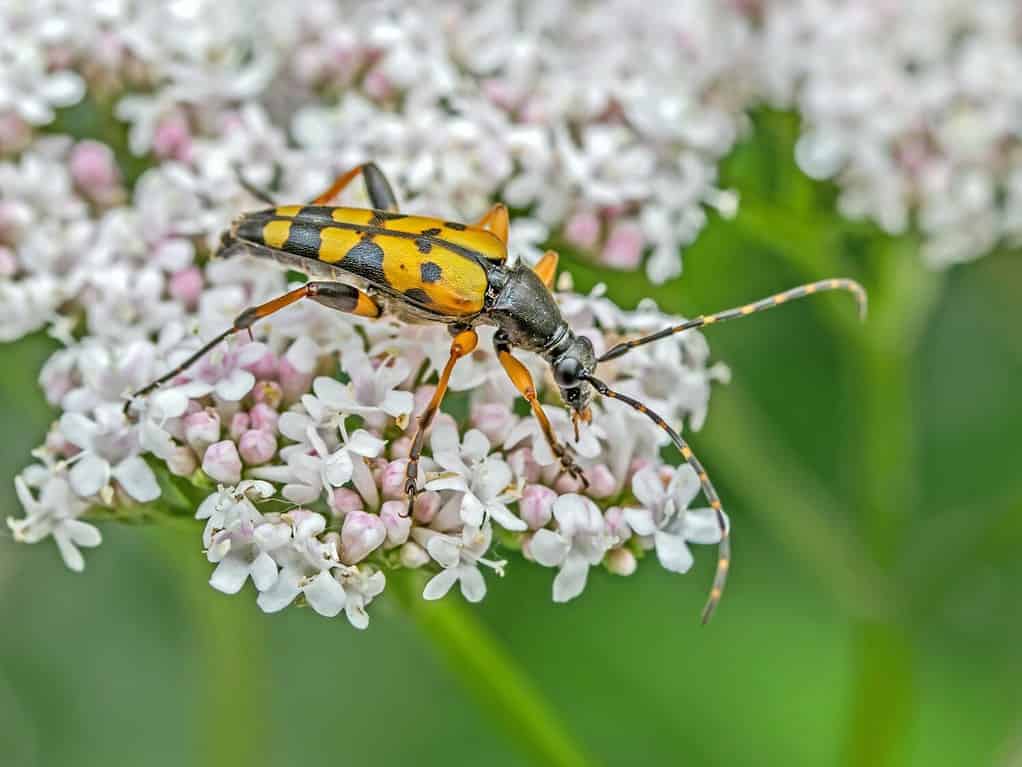
Black and yellow longhorn beetles are often found in deciduous forests, where they consume the wood of oak, hickory, maple, and other trees.
©Bildagentur Zoonar GmbH/Shutterstock.com
These beetles are native to North America and are a member of the Longhorn family, as you might guess from their name. Their black and yellow color distinguishes them from other longhorn beetles. Adults are anywhere from 8 to 16 mm long with very slender bodies. Their antennae are also very long – often the length of their body.
Black and yellow longhorn beetles are often found in deciduous forests, where they consume the wood of oak, hickory, maple, and other trees. Their larvae also eat the wood of these trees, causing considerable damage.
With that said, they aren’t considered a serious pest. They don’t cause widespread damage to forests or crops. Instead, their attacks are usually concentrated on a single tree or group of trees.
These beetles have interesting mating behavior. When a male and female meet, the male taps his antennae to hers, which helps him determine if she is receptive. After they mate, the female lays the eggs in the crevice of a tree.
Black and yellow longhorn beetles help break down decomposing wood, which helps enrich the surrounding soil. They may even support the health of new trees by removing old, decaying ones.
5. Black and Yellow Blister Beetle
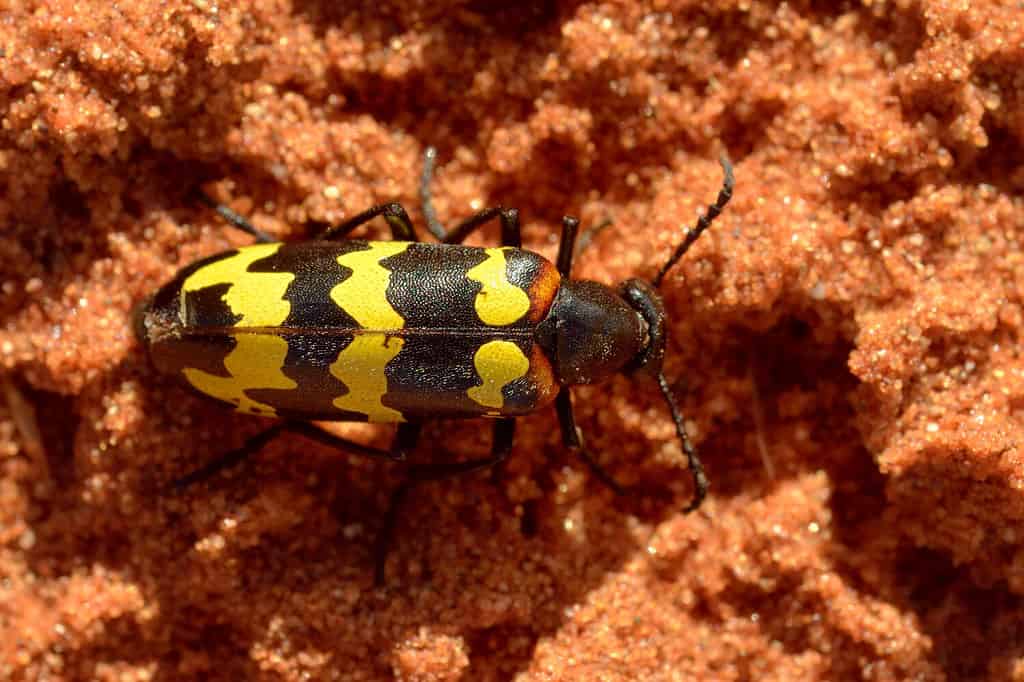
Because of their ability to produce caustic chemicals, they are sometimes utilized in traditional medicine.
©D. Kucharski K. Kucharska/Shutterstock.com
The black and yellow blister beetle is found throughout North America. The name “blister beetle” arises from the beetle’s ability to secrete a caustic chemical, which can cause blisters and skin irritation. For this reason, we don’t recommend touching these beetles with your bare hands.
With that said, they don’t necessarily cause tons of damage when touched, so they aren’t considered to pose serious threats. However, consuming them can cause blistering of the digestive tracts and other internal organs (though we don’t imagine that occurring all that much).
These beetles can grow longer than others, reaching around 1-2 cm long. They have a distinctive black and yellow coloration.
They like to hang around agricultural areas, where they may do a bit of damage. They’re particularly prone to damaging beans, potatoes, and alfalfa.
Because of their ability to produce caustic chemicals, they are sometimes utilized in traditional medicine. The chemicals they emit may have medicinal properties. However, their medical use is controversial and should only be attempted with a trained professional.
6. Yellow-Banded Longhorn Beetle
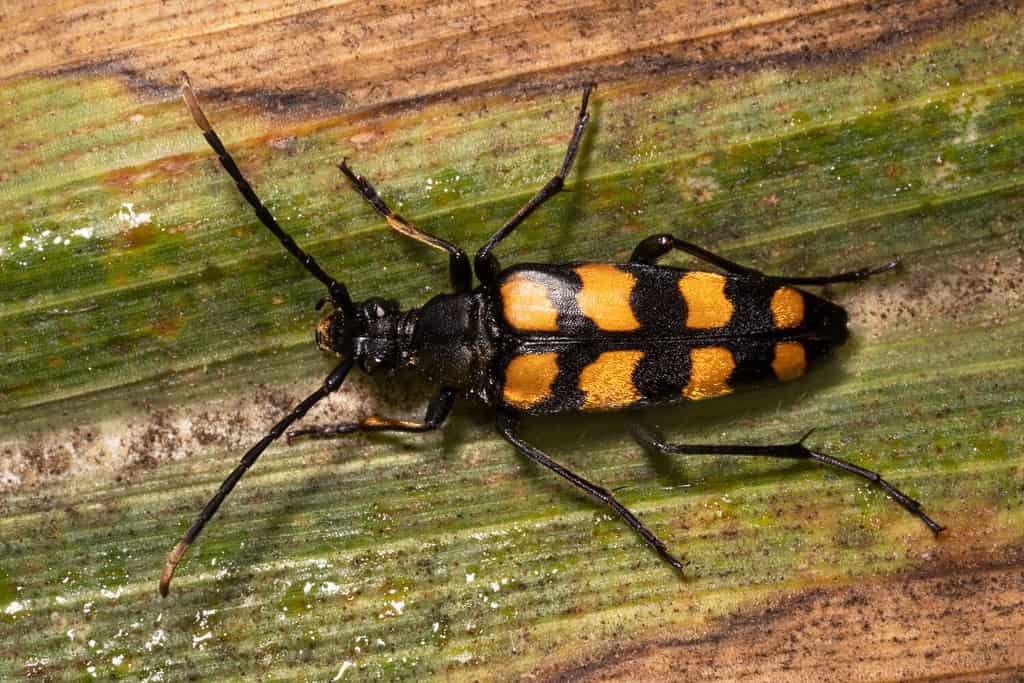
Yellow-banded longhorn beetles are found throughout much of North America.
©Ksenia Lada/Shutterstock.com
While we’ve already discussed one longhorn beetle species, the yellow-banded longhorn beetle is different. They have distinctive yellow bands across their body, which make them easy to identify.
They’re relatively large insects, measuring up to 3 cm long. They also have long antennae, like most longhorn beetles, which they use for sensing their environment.
Yellow-banded longhorn beetles are found throughout much of North America. They’re most commonly found in woodlands, forests, and grasslands. They feed on the wood and bark of trees. Despite this, they don’t commonly damage large swaths of trees, so they aren’t considered significant threats to their environments.
They lay their eggs on the bark of trees. Once the larvae hatch, they burrow into the tree, where they live for several years. Once they’re ready to turn into adults, the beetles emerge from the tree and make a cocoon.
7. Striped Flea Beetle
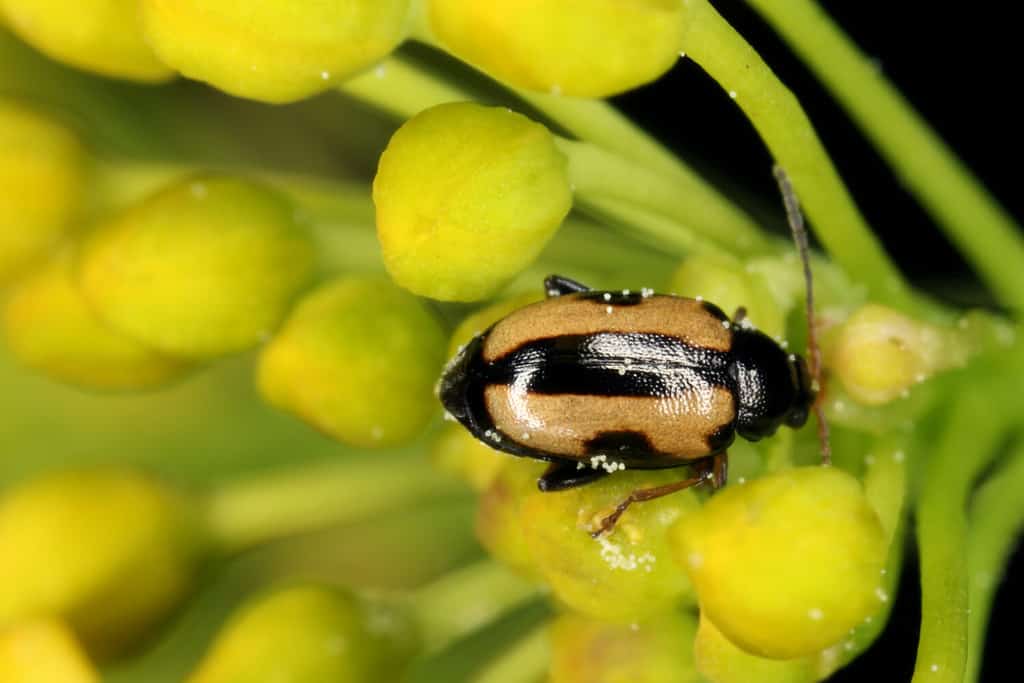
Adults feed on the leaves of anything they can find, though they prefer mustard plants like cauliflower, cabbage, and broccoli.
©Tomasz Klejdysz/Shutterstock.com
The striped flea beetle can be found from Alaska to Mexico, making them one of the farthest-reaching species on this list. Their distinctive yellow stripes set them apart from other flea beetles.
They’re around 4 mm long and very slender. Like most other species in the flea beetle family, they have extraordinary jumping abilities. They can quickly move from plant to plant by jumping.
Adults feed on the leaves of anything they can find, though they prefer mustard plants like cauliflower, cabbage, and broccoli. They can significantly damage crops, so they are often considered pests. The larvae also feed on plants, stunting growth and reducing crop yield. Luckily, insecticides can control these beetles.
In a natural setting, they help to break plant matter down and add nutrients to the soil. Several different predators, including birds and spiders, also consume them.
8. Black and Yellow Lichen Beetle
These small, black, and yellow beetles are found on lichens throughout North America, hence their name. They’re extremely small, only measuring a max of 5 mm. Their distinctive coloration makes them easy to identify and lets predators know they are potentially toxic.
Lichen is made up of two components: algae and fungi. These two components grow together in a symbiotic relationship. The black and yellow lichen beetle feeds on the algae component of the lichen, sometimes doing serious damage to the lichen colony.
While they can damage lichen, these beetles aren’t considered pests and don’t pose a serious risk to forests.
Male beetles guard females to prevent other males from breeding with them – a rare insect behavior. The female lays eggs on lichen, and the larvae feed on the algae like adults.
9. Yellow-Horned Clerid Beetle
These beetles belong to the Cleridae family, a common beetle family in North America. They’re particularly common in the western United States.
The adults are rather small, only measuring about 10 mm long. They’re characterized by their yellow “horns,” which give them their name.
The yellow-horned clerid beetles consume almost everything, making them “generalist” feeders. They may feed on other insects, foliage, and flowers. They consume several pest species, like carpet beetles. Therefore, they’re often well-liked by farmers.
With that said, they can also be considered a pest themselves. They may invade food stores and cause serious damage, especially to grains and cereals.
10. Four-Banded Longhorn Beetles

Yellow-banded longhorn beetles are found throughout much of North America.
©Ksenia Lada/Shutterstock.com
This species of beetle is another longhorn beetle. They’re found throughout several areas of North America, especially in the western United States.
These beetles are black with yellowish-white bands across their hardened wings. Their long antennae help them navigate their environment and find potential mates. They are smaller than other longhorn beetles, only growing to about 20 mm.
Four-banded longhorn beetles lay their eggs inside dead or dying trees. Once the eggs hatch, the larvae consume the dead wood. They have a distinctive C-shaped body that can be several centimeters long.
Adults consume nectar and pollen – not wood. They’re pollinators, making them essential for a plant’s lifecycle.
This beetle isn’t considered a pest species, but it can do some damage in large numbers. Luckily, they are often kept in check by natural predators.
11. Yellow Fungus Beetle

These beetles are often found near decaying materials where some fungus has grown. They consume this fungus and any small insects that may be around.
©Alen thien/Shutterstock.com
This small beetle only grows to about 8 to 11 mm long. It has a distinctive black and yellow color that sets it apart from similar beetles. They’re found worldwide, including parts of North America, Europe, and Asia.
These beetles are often found near decaying materials where some fungus has grown. They consume this fungus and any small insects that may be around.
When threatened, these beetles produce a toxic chemical. It isn’t deadly, but it can irritate human eyes and skin. Therefore, it is best not to handle these beetles without care and gloves.
These beetles aren’t considered pests and don’t damage commercial crops.
12. Spotted Pine Sawyer Beetle
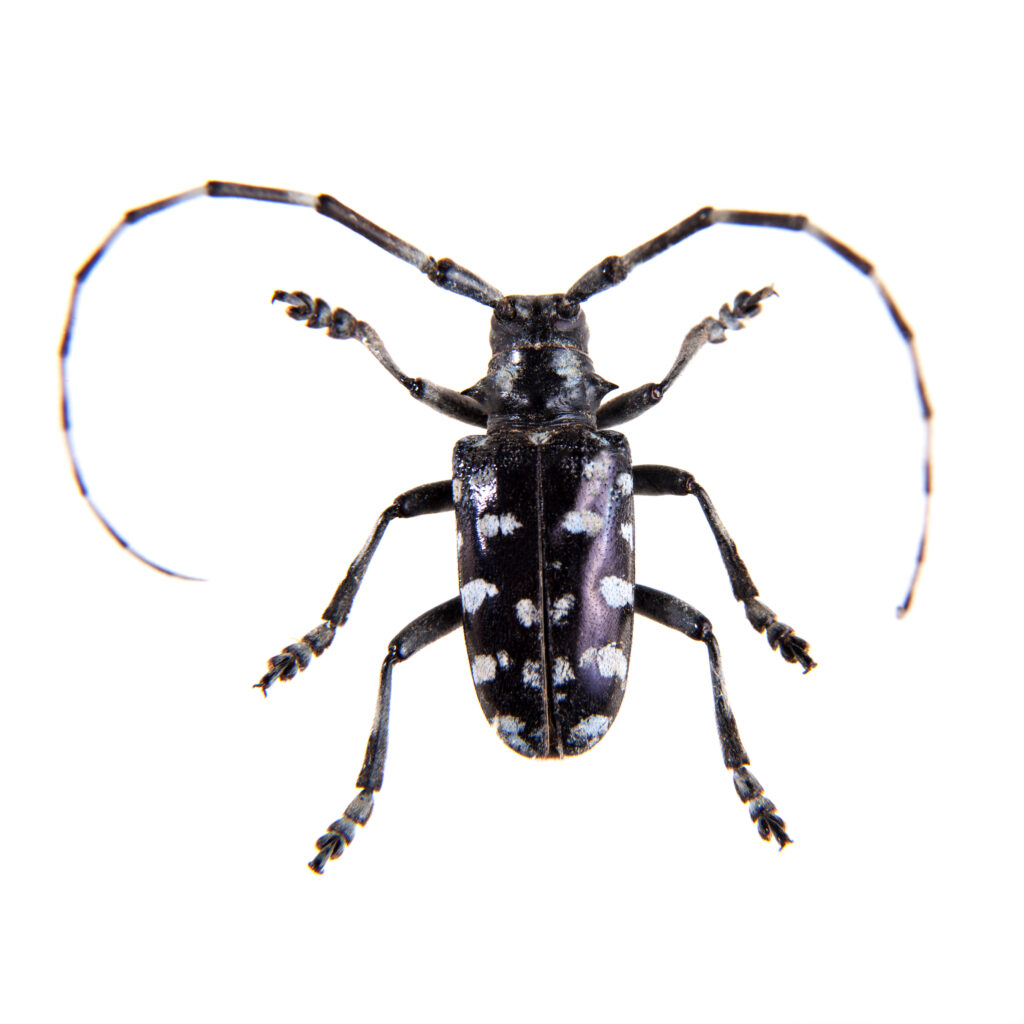
This beetle consumes the bark and sapwood of pine trees, hence their name.
©Rosa Jay/Shutterstock.com
The spotted pine sawyer beetle is a large, longhorn beetle that is usually black and yellow. However, the yellow coloration does vary. Sometimes, it is more of a brown-tan color, and other times, it is hardly there.
They’re found in North America from Canada to Mexico. The adults can grow up to 1.5 inches long, making them one of the largest insects on this list. Their bodies are elongated and slender. Their long antennae can be as long as the rest of their body.
This beetle consumes the bark and sapwood of pine trees, hence their name. The larvae will burrow into the wood to feed, which can cause significant damage to the trees. Often, the trees survive. However, trees stressed by disease, drought, or other factors may perish.
They are also a vector for pine wilt disease, which can easily kill pine trees. This disease is transmitted by a mite that lives on the beetle. When the beetle feeds, the mite can be transferred to the tree, where it can transmit the disease.
13. Asiatic Garden Beetle
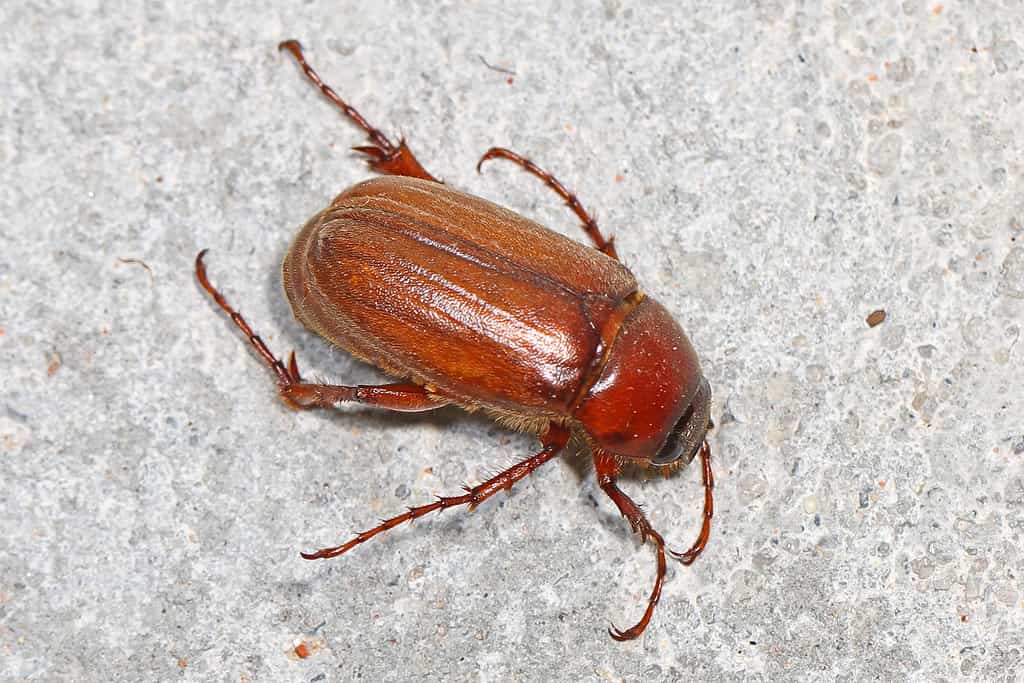
The larvae of the Asiatic garden beetle feed on the roots of several different types of plants, including vegetables, crops, and ornamental plants.
©https://www.flickr.com/photos/52450054@N04/8242419407/ – License
As its name suggests, the Asiatic garden beetle is native to Asia. However, it has been introduced to much of North America, where it is considered a pest and invasive species. The beetles only grow to half an inch long. They have a distinctive yellow and black coloration.
Their head is black, while their wing covers are yellowish brown.
The larvae feed on the roots of several different types of plants, including vegetables, crops, and ornamental plants. They can cause serious damage to plants, reducing growth and yield.
Adult beetles can also harm plants. They feed on the foliage and flowers of plants, which can reduce the plant’s ability to photosynthesize. The adults are active at night and attracted to light sources, making them a nuisance around homes and other buildings.
The larvae are difficult to detect and control.
14. Margined Blister Beetle

Margined blister beetles share a common defensive mechanism with all other blister beetles.
©Liz Weber/Shutterstock.com
The margined blister beetle is found throughout several regions of North America, including the western United States. For the most part, these beetles are black. However, they can have a yellow thorax, and other markings may appear yellowish-brown.
The adults of this plant consume foliage and flowers of plants. They’re particularly attracted to the plants of the sunflower family. However, they will consume just about anything, though.
These beetles secret a toxic chemical called cantharidin, which can cause blistering and skin irritation. It can cause illness and death if ingested. Luckily, very few people consume these beetles (for obvious reasons).
The larvae of these beetles feed on grasshopper eggs. They are laid on the ground. When they hatch, they find and consume eggs.
15. Red-Shouldered Pine Borer
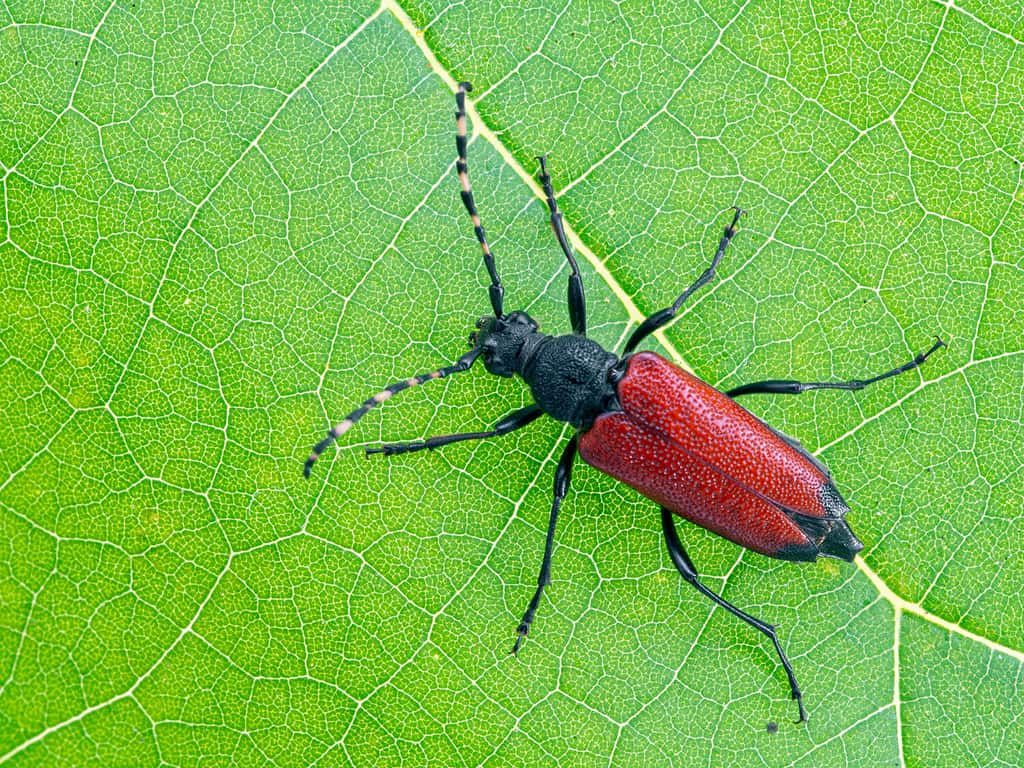
Efforts have been taken to control the population where it is invasive, including using pheromones to lure and trap the beetles.
©Ernie Cooper/Shutterstock.com
The red-shouldered pine borer is a species of longhorn beetle native to Europe. However, they have invaded parts of North America, including pine forests. They can do considerable damage in these areas, as native predators don’t easily control them.
These beetles are most active during the summer months. They feed on the bark and wood of pine trees. The females lay their eggs in the trees. When they hatch, the larvae tunnel into the tree’s bark, consuming the wood. This activity can severely damage the tree.
They can do considerable damage to pine forests. Efforts have been taken to control the population where it is invasive, including using pheromones to lure and trap the beetles.
While they most commonly shop in pine trees, they can also infest spruce, fir, and other conifers.
Are Black and Yellow Longhorn Beetles Poisonous?

The Asian longhorn beetle is one of the most invasive beetle species in the world.
©Kurit afshen/Shutterstock.com
The Asian longhorned beetle scientifically known as Anoplophora glabripennis, is an extremely damaging wood-boring pest that primarily targets maples and various hardwood trees, such as poplar, birch, and willow. This invasive beetle has a destructive impact, infesting and ultimately killing otherwise healthy trees, causing extensive harm to both urban and rural communities.
Asian long-horned beetles do not pose a direct threat to humans. These beetles won’t bite, prod, or sting. Nevertheless, they can have substantial indirect effects on health. Their wood-boring behavior leads to the demise of trees from within.
These harmless insects have a curious way of trying to ward off potential predators by convincing them that they possess a formidable sting.
The photo featured at the top of this post is © Liz Weber/Shutterstock.com
Thank you for reading! Have some feedback for us? Contact the AZ Animals editorial team.



